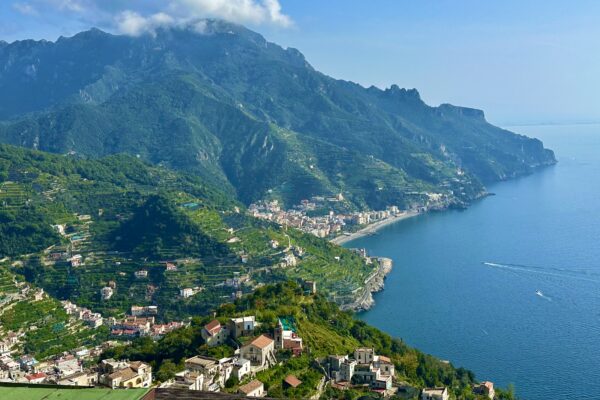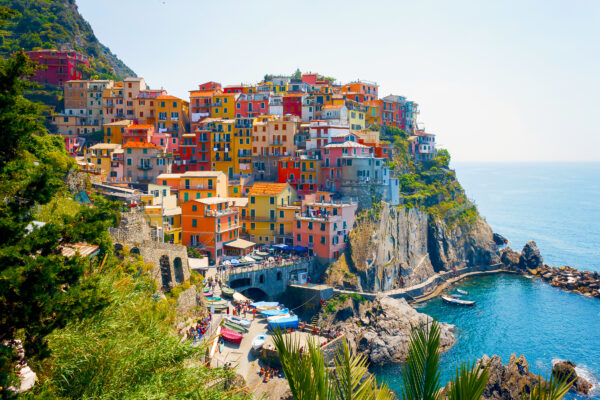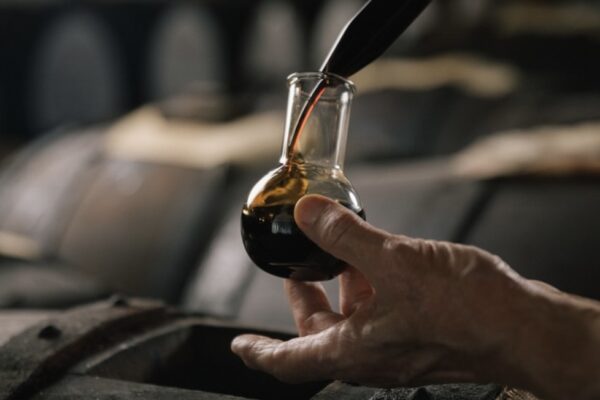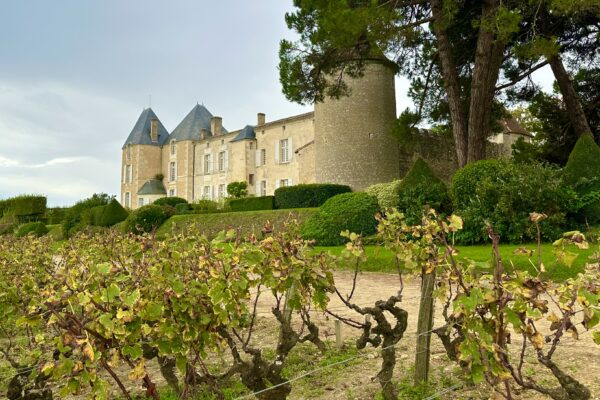Emilia-Romagna: Bologna & Ravenna

Colossal statue of Neptune in Bologna’s Piazza Maggiore. Photo by Marla Norman.
by Michel Thibault & Marla Norman
We were eager to spend a few days in Bologna because of its reputation as a food hub. The city offers more high quality food products with D.O.P. (Denomination of Protected Origin) than anywhere else in Italy. In fact, it is the birthplace of Lasagna and also known for its Salumi and Mortadella. But of course, Marla and I have traveled this far for some samples of Spaghetti Bolognese.
And yet, when we order, our waiter tells us that “Spaghetti Bolognese doesn’t exist.” Say what? Are you messing with us because we are tourists? Did my white socks tell you we were country bumpkins come to town?
In fact, he’s right. There is no Spaghetti Bolognese — it’s a pure invention of tourists. The real name for this dish is “Tagliatelle al Ragù” a real Bologna specialty. Of course many local restaurants now call it “Tagliatelle alla Bolognese” to let folks like us know this might be the dish they are looking for. Tagliatelle (don’t pronounce the g) is the egg pasta while the Ragù is actually the meat sauce.

Tagliatelle al Ragù – a Bolognese specialty. Squisito!
I won’t try to give you a recipe as there are a gazillion (a Marla word) on the internet. But I can tell you that in Bologna, two restaurants made the better TAR (Like my abbreviation?) and they are: Al Sangiovese and Oltre. While each has slightly different recipes, they both display the triumphant side of Italian cuisine — Simplicity becomes divine!
The silken touch of the tagliatelle married to the soft wheat flour and fused with a thick meat sauce of ground beef and onions braised at low heat for a long time, is breathtaking. My problem is that I cannot stop eating that stuff until my stomach hurts!
But let’s get back to Bologna foods before I get lost… For the finest Mortadella, check out Salumeria Simoni. We buy a couple of Mortadella sandwiches plus some cream of Parmigiano and devour the whole thing on a park bench…real life stuff. Another fun place is Ristorante Diana. There, the specialty is very much the Tortellini al Brodo — the only way to eat Tortellini they say. Brodo is a broth of meats, onion, carrots and celery. The broth lightly flavors the Tortellini and…Boom!! Once again a simple dish made outstanding!

Fra Diavolo – Excellent pizza and a bit of Italian advice. Photo by Marla Norman
The finest Lasagna is at Trattoria Dame. You have to trust me on this one. When I was a small child, my parents worked all day long and an Italian nanny kept me for many months and we ate Lasagna…almost every day.
But I would be remiss if I did not give you the name of the finest experience we had in Bologna: Ristorante Ciacco. We knew we were in for a great experience when it was the ONE recommendation from the manager of our B & B (which was Casa Bertagni by the way). He definitely sounded as if he loves Food.
I like a restaurant when it gives me at least three of the five elements I am looking for: great food, good value for the money, interesting selections, an excellent wine list and good to great service. Ciacco has it all plus a very romantic setting — extra pleasant after all the street activity in this very busy university town.

Romantic setting at Ristorante Ciacco. Photo by Salvatore Ciacco.
LAST STOP: RAVENNA
Michel and I make a final stop on our Emilia-Romagna tour in Ravenna — a beautiful little city on the Adriatic coast, some 80 miles south of Venice. Ravenna dates back to the 5th century BC and has a long, fascinating history — a few highlights here:
In the 3rd century BC, Julius Caesar gathered his forces to cross Ravenna’s primary river, the Rubicon. It was a monumental event that marked the official beginning of the Roman civil war between Caesar’s followers and those of Pompey, another popular Roman general. Short version: Caesar won. But this initial battle also perpetuated the famous cliche: “crossing the Rubicon” or “passing the point of no return.”
A few centuries later, in 402 AD as the Visigoths ravaged Rome, Emperor Honorius fled to Ravenna, taking the Empire’s capital with him, where it remained for most of the 5th century.
In 540 AD, Ravenna became part of the Byzantine Empire. It was during this period that Ravenna’s artisans created exquisite mosaics. Renowned still today, Ravenna is home to a number of workshops and prestigious schools for mosaic art.

Basilica di San Vitale – site of Ravenna’s renowned mosaics. Photo by Marla Norman.
BYZANTINE TREASURES
The weather is not cooperating in the least as we set out to visit the famous mosaics. Lightning rips across the sky and a deluge of rain pours down on us as we make a dash for the Basilica di San Vitale.
Inside the dark vestibule, we stand panting for a few moments, trying to catch our breath. Then, feeling recovered, we enter the nave and lose our breath all over again. Brilliant mosaics cover every bit of the walls, ceiling and domes. Astonishing! Pieces of gold, colored glass and mother-of-pearl shimmer and gleam at every turn. Quite a contrast to the dark, gloomy weather outside.
We walk from corner to corner, straining to see the various portraits and figures: angels, evangelists, Biblical characters, a profusion of flowers, stars, peacocks and other animals. Colors are so vivid and jewel-like — impossible to believe these images were created 1,500 years ago!

Interior mosaics of Basilica di San Vitale. Photo by Marla Norman.
Adjacent to the Basilica is the small tomb of Galla Placidia, sister of the Roman Emperor Honorius. The simple redbrick exterior contrasts with the rich mosaics that again cover ever square inch of the interior. Golden stars shine on a midnight blue background. A rendition of Christ as the Good Shepherd is the centerpiece.

Good Shepherd mosaic in the Mausoleum of Galla Placidia. Photo by Marla Norman.
We brave the storm again to see the Battistero deli Ariani — here an enormous mosaic within the dome of the church depicts Christ being baptized by John the Baptist. A procession of Apostles led by Saints Peter and Paul circle around the two main figures.

Baptism of Christ at Battistero deli Ariani. Photo by Marla Norman.
MERCATO COPERTO DI RAVENNA
There are eight major religious sites in Ravenna — all with Unesco World Heritage designations. We’d hoped to see at least five, but we’re soaked and in desperate need of a warm place and adult beverages. So, we make our way to the Mercato Coperto di Ravenna, which although extremely modern, dates back to the Middle Ages when it was a trading center for fishermen and butchers. Today, there is a restaurant, a produce market, bakery, wine shop, cheese, pasta and ice cream vending — all offering tastes of their goods.
We plop down at the restaurant and order Ravioli filled with branzino and asparagus as well as the Gran Fritto del Mercato — a huge platter of battered shrimp, calamari and vegetables. Michel selects a bottle of Franciacorta to accompany our feast. This Italian sparkling has become our go-to wine throughout the trip.

Mercato Coperto di Ravenna – shops, markets and dining. Photo courtesy of Ravenna Turismo.
After lunch, we wander around the market, enjoying the lively atmosphere and beautiful displays of food. I can’t resist all the unusual pastas and purchase a stack to enjoy back home.
Eventually, we take a peak outside and see that the weather has finally let up. There’s even a rainbow. Taking that as a good omen, we decide to make one last stop — Dante Alighieri’s tomb. One of the world’s greatest authors, Dante published his “Divine Comedy” in 1321. Writers over the centuries, from Chaucer, Shakespeare, Tennyson, Longfellow, T.S.Eliot and Borges to LeRoi Jones have acknowledged his influence.

Dante Alighieri’s tomb in Ravenna, with an oil lamp provided by the citizens of Florence. Photo courtesy of Ravenna Turismo.
Originally from Florence, Dante was exiled from his home and spent much of his life in Ravenna. It was here that he wrote the “Divine Comedy.” Years after his death, the city of Florence begged to have the remains of Dante returned to his birthplace. Not surprisingly, the citizens of Ravenna refused. They do, however, allow the Florentines to provide the oil that burns above his tomb.
We pay our respects to the genius writer and make our way back to the car. Exhausted, thrilled, still damp… a little hell, a little comedy but mostly divine experiences… just the way travel should be.
Click here to see more of our travels in Italy.








